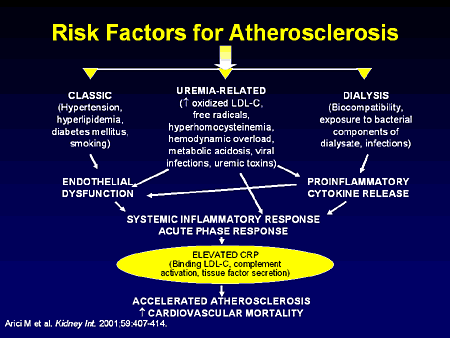Wayne State discovers potential treatment for better heart health in hemodialysis patients
Researchers at Wayne State University have discovered a potential way to improve the lipid profiles in patients undergoing hemodialysis that may prevent cardiovascular disease common in these patients. Patients undergoing hemodialysis for kidney failure are at a greater risk for atherosclerosis, a common disease in which plaque builds up inside the arteries. Atherosclerosis can lead to serious problems including heart attack, stroke or even death.
The team of researchers discovered that a unique combination of vitamin E isomers known as tocotrienols improved the patients’ lipid profiles. The study, “Vitamin E tocotrienol supplementation improves lipid profiles in chronic hemodialysis patients,” was published in a recent issue of the journal, Vascular Health Risk Management, and showed that patients in the randomized double-blind, placebo-controlled parallel trial who were given the vitamin E supplement had notable improvement in their lipid profiles compared to those given the placebo.
“After 12 and 16 weeks of intervention, the hemodialysis patients taking the Vitamin E supplements showed significant improvements in their blood lipid profiles,” said Pramod Khosla, Ph.D., associate professor of nutrition & food science in Wayne State University’s College of Liberal Arts and Sciences. “Specifically, their triglycerides were reduced and their HDL cholesterol levels increased, as compared to the placebo group.”
“This study could potentially have positive clinical implications in the future for hemodialysis patients that need to improve their triglyceride and HDL levels, but first these findings need to be verified in a much larger group of subjects. Additionally, we need to tease out the interactive effects of the tocotrienols with various medications that are routinely prescribed to these patients,” added Khosla.
Atherosclerosis (or arteriosclerotic vascular disease) is a condition where the arteries become narrowed and hardened due to an excessive build up of plaque around the artery wall. The disease disrupts the flow of blood around the body, posing serious cardiovascular complications.
Arteries contain what is called an endothelium, a thin layer of cells that keeps the artery smooth and allows blood to flow easily. Atherosclerosis starts when the endothelium becomes damaged, allowing LDL cholesterol to accumulate in the artery wall. The body sends macrophage white blood cells to clean up the cholesterol, but sometimes the cells get stuck there at the affected site. Over time this results in plaque being built up, consisting of bad cholesterol (LDL cholesterol) and macrophage white blood cells.
The plaque clogs up the artery, disrupting the flow of blood around the body. This potentially causes blood clots that can result in life-threatening conditions such as heart attack, stroke and other cardiovascular diseases.
 “Accelerated cardiovascular disease is a major problem in the end-stage renal disease population, and these findings may lead to new approaches to understanding its pathophysiology and to treatment,” commented James Sondheimer, M.D., associate professor of internal medicine in Wayne State’s School of Medicine. “A multicenter trial to confirm these findings and determine clinical significance is clearly called for.” Sondheimer was not involved in the study.
“Accelerated cardiovascular disease is a major problem in the end-stage renal disease population, and these findings may lead to new approaches to understanding its pathophysiology and to treatment,” commented James Sondheimer, M.D., associate professor of internal medicine in Wayne State’s School of Medicine. “A multicenter trial to confirm these findings and determine clinical significance is clearly called for.” Sondheimer was not involved in the study.
###
In addition to this study, Khosla’s research team is focused on dietary and lifestyle changes and how they impact lipid metabolism, as well as the nutritional aspects of palm oil. For more information about Khosla, visit clasweb.clas.wayne.edu/aa0987.
What Causes Atherosclerosis?
First, an Anatomy 101 review: Arteries are blood vessels that carry blood from the heart throughout the body. They’re lined by a thin layer of cells called the endothelium. The endothelium works to keep the inside of arteries toned and smooth, which keeps blood flowing.
“Atherosclerosis starts when high blood pressure, smoking, or High cholesterol damage the endothelium,” says Richard Stein, MD, national spokesperson for the American Heart Association. “At that point, cholesterol plaque formation begins.”
Cholesterol invasion. Bad cholesterol, or LDL, crosses damaged endothelium. The cholesterol enters the wall of the artery.
Plaque formation. Your white blood cells stream in to digest the LDL cholesterol. Over years, the accumulating mess of cholesterol and cells becomes a plaque in the wall of the artery.
“It’s a jumble of lipids, or cholesterol, cells, and debris, and it creates a bump on the artery wall,” explains Stein. As the process of atherosclerosis continues, “the bump gets bigger.” A big enough bump can create a blockage.
Atherosclerosis tends to happen throughout the body. “So if you have plaque in your heart, you’re at a higher risk for stroke, and vice versa,” says Stein.
Atherosclerosis usually causes no symptoms until middle or older age. Once narrowings become severe, they choke off blood flow and can cause pain. Blockages can also suddenly rupture, causing blood to clot inside an artery at the site of the rupture.
Wayne State University is one of the nation’s pre-eminent public research universities in an urban setting. Through its multidisciplinary approach to research and education, and its ongoing collaboration with government, industry and other institutions, the university seeks to enhance economic growth and improve the quality of life in the city of Detroit, state of Michigan and throughout the world.
###
Julie O’Connor
julie.oconnor@wayne.edu
313-577-8845
Wayne State University - Office of the Vice President for Research